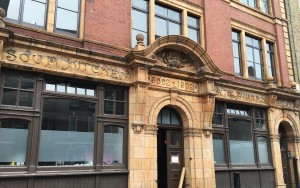Located at the edge of the City, Spitalfields has always been a place of social upheaval and a melting pot of cultures; catering to both domestic and international immigrants arriving in London as early as the seventeenth century. Katie, who runs Look Up London Walking Tours on Funzing.com, is giving you a sneak peak.
Here are five Spitalfields sights you miss when you don’t look up…
1. Jewish Soup Kitchen on Brune Street
In the nineteenth century, the Jewish population of Spitalfields was growing steadily, reaching its peak in the 1880s. This Soup Kitchen, which opened in 1902, was one of several charity kitchens for the Jewish poor in the East End which at its height provided meals for over 5,000 people a week. It closed in 1992 but the building still has its distinctive signage. And if you’re puzzled by the figure 5662, it’s the year 1902 in the Jewish calendar.
2. Tenter Ground, E1
Weaving was one of the main trades in Spitalfields and this street name is a nod to that practice; textile workers would stretch out woven cloth on frames (or ‘tenters’) until they were taut, leaving them to dry outside held on by hooks. This was so it could dry evenly and prevent the material from shrinking. It’s where we get the phrase ‘on tenterhooks’ from.
3. A. Gold, 42 Brushfield Street
This building dates back to the 1780s and has been home to diamond cutters and boot makers. But one owner has kept their mark. Now a deli, the frontage still bears the name of Amelie Gold, a Hungarian Jew who lived here practising French millinery in the 1880s.
4. Fire Insurance Plaque, 37 Fournier Street
These would have been a common sight in eighteenth and nineteenth century London and were used by fire insurance companies to mark houses that had paid up. The one seen here is from the ‘Sun Fire Office’, established in 1710. Given that there was no national fire service, residents would pay a premium to ensure they would be helped in an emergency. However, if the wrong company arrived first it was common practice that they’d refuse to help you when they spotted a rival’s insignia on your building.
5. Providence Row Night Refuge and Convent on the corner of Crispin Street
Now used for student accommodation, this building used to be a temporary shelter for the area’s poor and vulnerable. It was founded in 1868 and remained in use until the 1970s, helping over 300 women and children and 50 men whose separate entrance signs are still visible above the doors. It’s also believed that Jane Kelly – the fifth official victim of Jack the Ripper – lived here when she arrived in London in 1884.
Intrigued? Find out more here and book your Look Up London tour.
Look our for dozens of other events, workshops and quirky experiences here.

